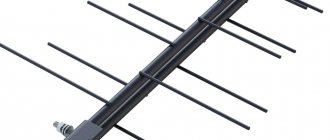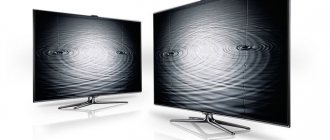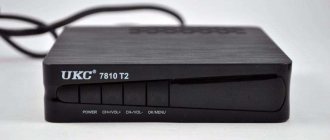Very often we hear such definitions as “digital” or “discrete” signal; what is its difference from “analog”?
The essence of the difference is that the analog signal is continuous in time (blue line), while the digital signal consists of a limited set of coordinates (red dots). If we reduce everything to coordinates, then any segment of an analog signal consists of an infinite number of coordinates. For a digital signal, the coordinates along the horizontal axis are located at regular intervals, in accordance with the sampling frequency. In the common Audio-CD format this is 44100 points per second. The vertical accuracy of the coordinate height corresponds to the bit depth of the digital signal; for 8 bits it is 256 levels, for 16 bits = 65536 and for 24 bits = 16777216 levels. The higher the bit depth (number of levels), the closer the vertical coordinates are to the original wave.
Analogue sources are: vinyl and audio cassettes. Digital sources are: CD-Audio, DVD-Audio, SA-CD (DSD) and files in WAVE and DSD formats (including derivatives of APE, Flac, Mp3, Ogg, etc.).
"In the beginning there was a signal..."
With these words, John began his Gospel, describing times beyond the borders of our era.
We begin this article with no less pathos, and seriously declare that in the business of broadcasting “in the beginning there was a signal.” In television, as in all electronics, the signal is the basis. When we talk about it, we mean electromagnetic oscillations that propagate in the air with the help of a transmitting antenna and cause current fluctuations in the receiving antenna. The broadcast wave can be presented in both continuous and pulsed form, which significantly affects the final result - the quality of TV reception.
What is analogue television? This is television, familiar to everyone, which was seen by our parents’ parents. It is broadcast in an unencrypted way, its basis is an analog signal, and it is received by an ordinary analog TV, familiar to us from childhood. Currently, in many countries the process of digitizing the analog signal, and therefore terrestrial television, is being carried out. In some European countries this process has already been completed and terrestrial analogue TV has been switched off. There are reasons for this, which this article suggests to understand.
Differences between a digital signal and an analog signal
For most people, the difference between an analog and digital signal can be quite subtle. And yet, their difference is significant and lies not simply in the quality of the television broadcast.
An analog signal is the received data that we see, hear and perceive as the world that surrounds us. This method of generating, processing, transmitting and recording signals is traditional and still very widespread. The data is converted into electromagnetic waves, reflecting the frequency and intensity of the phenomena according to the principle of complete correspondence.
A digital signal is a set of coordinates that describe an electromagnetic wave, which is not inaccessible to direct perception, without decoding, because is a sequence of electromagnetic pulses. Speaking about discreteness and continuity of signals, they mean, respectively, “taking values from a finite set” and “taking values from an infinite set.”
An example of discreteness would be school grades, which take values from the set 1,2,3,4,5. In fact, a digital video signal is often created by digitizing an analog signal.
You may be interested in: Indoor TV antenna general information
Moving away from theory, in reality we can highlight the following key differences between analog and digital signals:
- analogue television is vulnerable to interference that introduces noise into it, while the digital impulse is either completely blocked by interference and is absent, or arrives in its original form.
- Any device whose operation is based on the same principle as the transmitter’s broadcast can receive and read an analog signal. The digital wave is intended for a specific “addressee”, and therefore is resistant to interception, because securely encoded.
Image quality
The quality of the TV picture provided by analog TV is largely determined by the TV standard. The frame that carries analog broadcast includes 625 lines with an aspect ratio of 4x3. Thus, the old kinescope displays an image from television lines, while a digital image is made up of pixels.
Picture with analog signal
With poor reception and interference, the TV will “snow” and hiss, not providing the viewer with image and sound. In an attempt to improve this situation, cable TV was implemented at one time.
Picture with digital signal
Other options
Despite the rapid development of electronic technology and the advantages of digital signal over analog, there are still areas in which analog technology is indispensable, such as professional audio processing. But, although the original recording may be no worse than the digital one, after editing and copying it will inevitably be noisy.
Here is a set of basic operations that can be performed with an analog stream:
- strengthening and weakening;
- modulation, aimed at reducing its susceptibility to interference, and demodulation;
- filtering and frequency processing;
- multiplication, summation and logarithm;
- processing and changing the parameters of its physical quantities.
DSD format
After the widespread use of delta-sigma DACs, it was quite logical for the emergence of a format for recording binary code directly to delta-sigma encoding.
This format is called DSD (Direct Stream Digital). The format was not widely used for several reasons. Editing files in this format turned out to be unnecessarily limited: you cannot mix streams, adjust volume, or apply equalization. This means that without loss of quality, you can only archive analog recordings and produce two-microphone recording of live performances without further processing. In a word, you can’t really make money.
In the fight against piracy, SA-CD format discs were not (and are still not) supported by computers, which makes it impossible to make copies of them. No copies – no wide audience. It was possible to play DSD audio content only from a separate SA-CD player from a proprietary disc. If for the PCM format there is an SPDIF standard for digital data transfer from a source to a separate DAC, then for the DSD format there is no standard and the first pirated copies of SA-CD discs were digitized from the analog outputs of SA-CD players (although the situation seems stupid, but in reality some recordings were released only on SA-CD, or the same recording on Audio-CD was deliberately made of poor quality to promote SA-CD).
The turning point occurred with the release of SONY game consoles, where the SA-CD disc was automatically copied to the console’s hard drive before playback. Fans of the DSD format took advantage of this. The appearance of pirated recordings stimulated the market to release separate DACs for playing DSD streams. Most external DACs with DSD support today support USB data transfer using the DoP format as a separate encoding of the digital signal via SPDIF.
Carrier frequencies for DSD are relatively small, 2.8 and 5.6 MHz, but this audio stream does not require any data reduction conversion and is quite competitive with high-resolution formats such as DVD-Audio.
There is no clear answer to the question of which is better, DSP or PCM. It all depends on the quality of implementation of a particular DAC and the talent of the sound engineer when recording the final file.
Features of analogue and digital television
The philistine judgment about the collapse of terrestrial TV and the transition to broadcasting technologies of the future is somewhat unfair, if only because TV viewers are replacing the concepts: terrestrial and analog TV. After all, terrestrial television is usually understood as any television broadcast over a terrestrial radio channel.
Both “analog” and “digital” are types of terrestrial TV. Despite the fact that analogue television differs from digital television, their general principle of broadcasting is identical - a television tower broadcasts channels and guarantees a high-quality signal only within a limited radius. At the same time, the digital coverage radius is shorter than the range of the unencoded stream, which means that repeaters must be installed closer to each other.
But the opinion that “digital” will ultimately surpass “analog” is true. TV viewers in many countries have already become “witnesses” of the conversion of an analogue signal to a digital one and are thoroughly enjoying watching TV programs in HD quality.
You may be interested in: The correct antenna for receiving DVB T2 digital television at the dacha
Features of broadcast television
digital television repeaters
The existing terrestrial television system uses analog signals to transmit television products. They propagate through highly oscillating waves, reaching terrestrial antennas. In order to increase the broadcast coverage area, repeaters are installed. Their function is to concentrate and amplify the signal, transmitting it to remote receivers. Signals are transmitted at a fixed frequency, so each channel corresponds to its own frequency and is assigned to the TV in numerical order.
Advantages and disadvantages of digital television broadcasting
Information transmitted using a digital code contains virtually no errors or distortions. The device that digitizes the original signal is called an analog-to-digital converter (ADC).
To encode pulses, a system of ones and zeros is used. To read and convert BCD code, a device called a digital-to-analog converter (DAC) is built into the receiver. There are no half values for either the ADC or DAC, such as 1.4 or 0.8.
This method of encrypting and transmitting data has given us a new TV format, which has many advantages:
- changing the strength or length of the pulse does not affect its recognition by the decoder;
- uniform broadcast coverage;
- unlike analogue broadcasting, reflections from obstacles of the converted broadcast add up and improve reception;
- broadcast frequencies are used more efficiently;
- It is possible to receive digital TV on an analog TV.
Sound
Sound quality is one of the most important characteristics of any radio. It depends on the size of the speakers, as well as the type of sound of the receiver. Like any other speaker system, a radio can produce both simple mono sound and more advanced stereo sound. It can be created either through two external speakers or through headphones (a standard 3.5 mm jack for connecting which is available on all receivers without exception). At the same time, do not forget that the sound quality (as well as the price of the receiver) depends on the size of the speakers; the larger they are, the better the sound and the more expensive the radio. If simple and unpretentious mono sound is enough for you, then you shouldn’t overpay for a more expensive stereo model.
The difference between digital television and analogue
The easiest way to notice the difference between analogue and digital broadcasting is to present the final characteristics of both technologies in the form of a table.
| Digital TV | Analog TV |
| The digital image resolution is 1280x720, giving a total of 921600 pixels. In the case of the 1080i scan format, the image resolution is 1920x1080, which gives an impressive result: more than 2 million 70 thousand pixels. | The maximum resolution of an analog "picture" is approximately 720x480, which gives a total of more than 340,000 pixels. |
| Sound | |
| Audio, like video, is transmitted without distortion. Many programs are accompanied by a surround stereo signal. | Sound quality varies. |
| Receiver | |
| The cost of a TV adapted for digital reception is several times higher than the price of a regular TV. | Analog TV is moderately expensive. |
| TV channels | |
| Watching digital channels gives the viewer a wide choice: a large number and thematic focus of TV channels. | Number of programs up to 100. |
| Other | |
| Reception of programs on one TV. Additional, “virtual cinema”, “program storage”, etc. | Possibility of connecting more receivers and simultaneously viewing several programs. |
| Bottom line | |
| The new television brings with it excellent picture and sound quality, the ability to create a multimedia home station for playing, working and learning. However, the high cost of adapted televisions and the slow introduction of TV encoding technology on the Russian market have so far left it behind existing television. | Good old TV is inferior to digital in image and sound quality. However, the price of the receivers and the ability to distribute the signal to a larger number of TVs (the ability to watch several programs at the same time) are a significant plus. |
You may be interested in: What does an HDMI cable look like?
FAQ
— Is it possible to rent a Wifire set-top box?
Answer: Equipment can be rented for 99 rubles per month or purchased for 4,800 rubles. The set-top box can be used as a media player for viewing videos and photos from USB drives. It gives access to extensive movie libraries from Megogo, ivi, Amediateka. With its help you can control the broadcast (pause, rewind, record for viewing).
Tariffs can be changed by the operator. Full up-to-date information on tariffs and or by phone indicated on the website.
TV antenna sensitivity
There is no universal recipe for choosing the ideal antenna, but there are mandatory requirements that must be met in order for it to receive analog and digital signals. As the distance from the broadcast object increases, these requirements increase. In particular, to the sensitivity of the receiver - its ability to pick up weak-intensity television signals. Often they are the cause of a blurry image. This problem is solved with the help of an amplifier, which significantly increases the sensitivity of the antenna and removes the question: how to connect it to digital television? The same TV, and the same antenna, only an over-the-air digital tuner will appear near the TV.
Advantages of AHD cameras
Here are some advantages of AHD cameras:
- Lossless signal transmission range up to 500m.
- Easy to install and use.
- High signal quality, up to FullHD level.
- The video signal is transmitted without delay.
- Low price.
- Possibility of building systems with different types of cameras.
Thus, AHD cameras are the “golden mean”, “video systems of the future”. In the vast majority of cases, they are the best choice for building your video surveillance system.
Now are you ready to make a choice?
We hope that the answer has become obvious to you. If not, write (or call) us, and together we will analyze the requirements for your system and help you make a choice. In the next step you will find recommendations for choosing CCTV cameras.
What is an antenna radiation pattern
In addition to the sensitivity of the antenna, there is a parameter that determines the extent to which it is able to focus energy. It is called directional gain or directivity, and is the ratio of the radiation density in a given direction to the average radiation density.
A graphical interpretation of this characteristic is the antenna radiation pattern. At its core, it is a three-dimensional figure, but for ease of work it is expressed in two planes located perpendicular to each other. Having such a flat diagram at hand and comparing it with a map of the area, you can plan the antenna reception area for an analog video signal. Also from this graph you can extract a number of useful practical characteristics of the TV antenna, such as the intensity of lateral and reverse radiation and the protective coefficient.
Which signal is better
It should be recognized that, despite many improvements implemented in the field of analog representation of information, this method of broadcasting has retained its shortcomings. These include distortion during transmission and noise during playback.
Also, the need to convert an analog signal to a digital one is caused by the unsuitability of the existing recording method for storing information in semiconductor memory.
Unfortunately, existing TV has virtually no obvious advantages over digital, excluding the possibility of receiving a signal with a regular TV antenna and sharing it between TVs.











